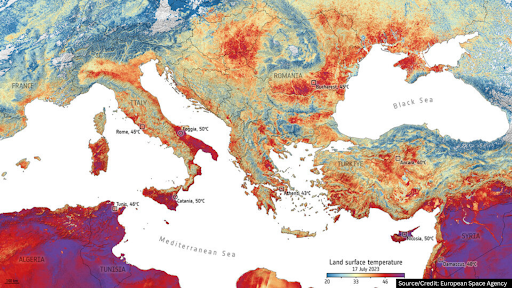
03 Sep European Heat Wave 2023: What You Should Know
The summer of 2023 has brought an extreme heat wave to the European region, which has pushed temperatures to all-time highs. This comes as the region continues to suffer record-breaking high temperatures. Amidst this struggle, eyes are on Italy, where temperatures are predicted to soar between 40°C to a blistering 45°C. Meteorologists speculate that the scorching European temperature record of 48.8°C in 2021 in Sicily might be surpassed this time. Meanwhile, Greece battles an onslaught of 52 forest fires in a mere 24 hours, courtesy of the unforgiving Cerberus heatwave. As if that weren’t enough, a second heatwave named Charon is swiftly following, promising even more extreme conditions.
Given the growing frequency of extreme weather events as a result of climate change, it is critical to be well-informed and prepared for the consequences of such heat waves. This article aims to provide you with vital information about the ongoing heat wave, its causes, potential risks, and effective strategies to mitigate it.
What Are the Reports Like in Parts of Europe?
A recent report from the Guardian revealed that between May 30 and September 4, 2022, heat claimed the lives of more than 61,000 people across Europe. The summer of 2022 was etched in the history books as Europe’s hottest ever recorded, with a relentless barrage of record-breaking heatwaves. Findings highlight the gravity of the situation, revealing Italy’s staggering death toll at 18,010, followed by Spain and Germany, reporting 11,324 and 8,173 heat-related deaths, respectively.
What caused the European Heat Wave?
The current heat wave can be attributed to a combination of factors, including a high-pressure system, climate change, and regional weather patterns. These factors have contributed to the persistence and severity of the heat wave, making it a significant concern for public health and safety.
The current heatwave, named Cerberus after the mythological three-headed guardian of the underworld, is caused by an anticyclone. An anticyclone is a normal meteorological occurrence where sinking air leads to dry, settled weather with minimal clouds and wind. These slow-moving high-pressure systems can persist for days or weeks, becoming semi-permanent features over large land areas. When they form over hot regions like the Sahara, the system’s stability amplifies temperatures, heating the already warm air even further.
Another contributing factor is unusually high sea surface temperatures, which means that cooler air is not blowing inland off the Mediterranean. A picture of the Earth showing the land surface temperature on July 17, 2023, is presented below. It was received from the Copernicus Sentinel-3 instrument and is available at the European Space Agency.
What are the Health Implications Associated with the Health Wave?
Heatwaves are the primary cause of death in Europe among weather- and climate-related events, and without control measures, the frequency of extreme heat episodes could lead to higher morbidity and mortality. According to the WHO, mortality due to heat among people over the age of 65 has nearly doubled over the past two decades, with deaths in the European Region alone rising by more than 30%.
Heat wave-related poor health outcomes include age, pre-existing medical conditions, and social deprivation. Additionally, individuals with chronic illnesses, pregnant women, outdoor labourers, and people living in socially and economically disadvantaged areas also fall into vulnerable categories.
Important health issues with heatwaves include stress and dehydration, or indirect effects such as cardiovascular, respiratory, renal, and electrolyte issues, usually manifesting within three days of exposure.
The negative impact of heat waves also has wide-ranging economic implications. Findings show that between 2015 and 2019, the economic impact of heat-related health effects cost the European Region an estimated €23.2 billion in mortality, €2.3 billion in minor restricted activity days, and €0.031 billion in morbidity.
Mitigating the health impacts of heat will require concerted political efforts and strategies. There should be effective strategies such as heat health action plans, urban greening, proper building design, and flexible working conditions. Early warnings from vector monitoring and illness surveillance are also critical for targeted interventions, which necessitate collaboration among the public health, built environment, spatial planning, and employment sectors.
Conclusion
Finally, the European heat wave of 2023 requires our attention and action. Given that the frequency of heatwaves in Europe and around the world poses a significant threat to public health, particularly among vulnerable populations, the increased risk of exposure to extreme heat increases the mortality rate, spreads climate-sensitive infectious diseases, and so on. All stakeholders must work together to address this common threat. This necessitates quick and concerted action, such as heat health action plans, urban greening, proper building design, and flexible working arrangements. Furthermore, by putting vulnerable individuals and communities first, we can develop resilience and protect public health in the face of growing heatwaves and climate problems.

No Comments